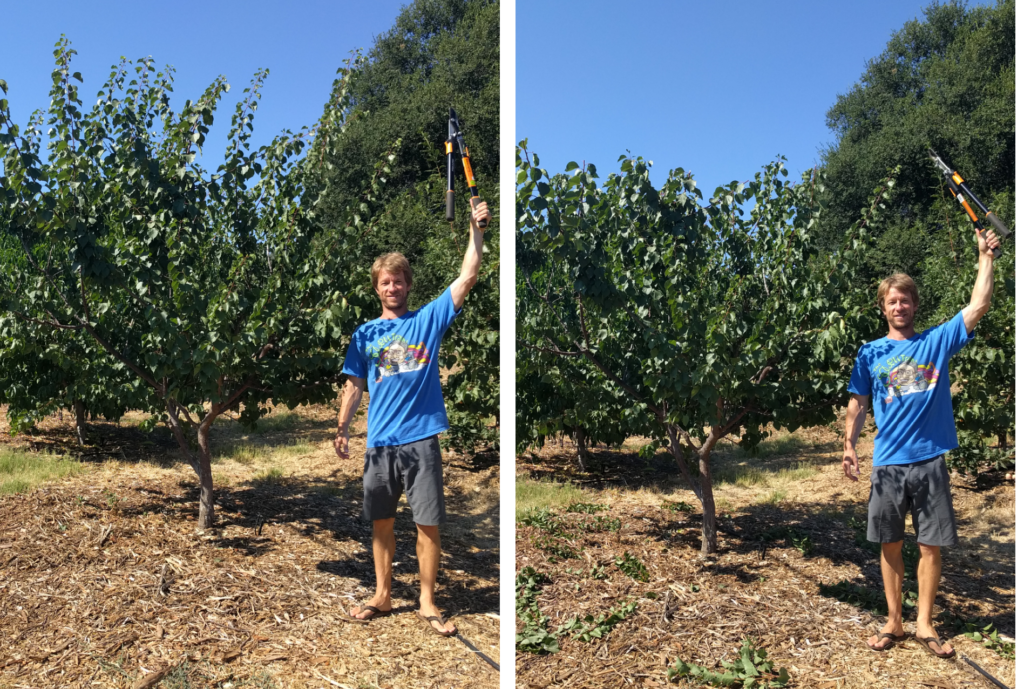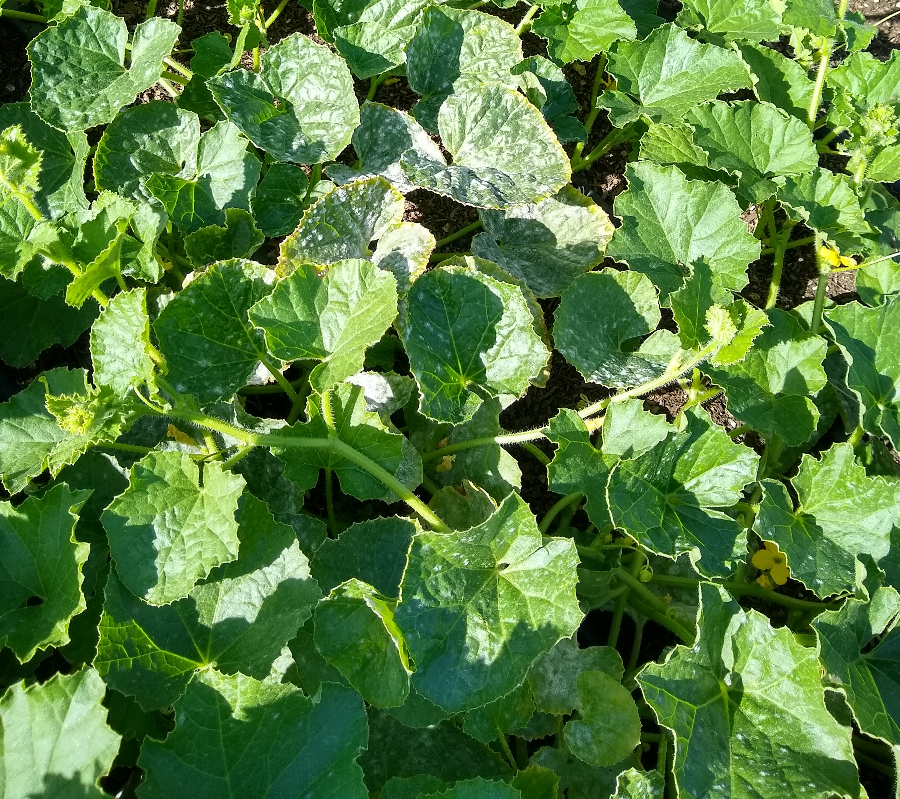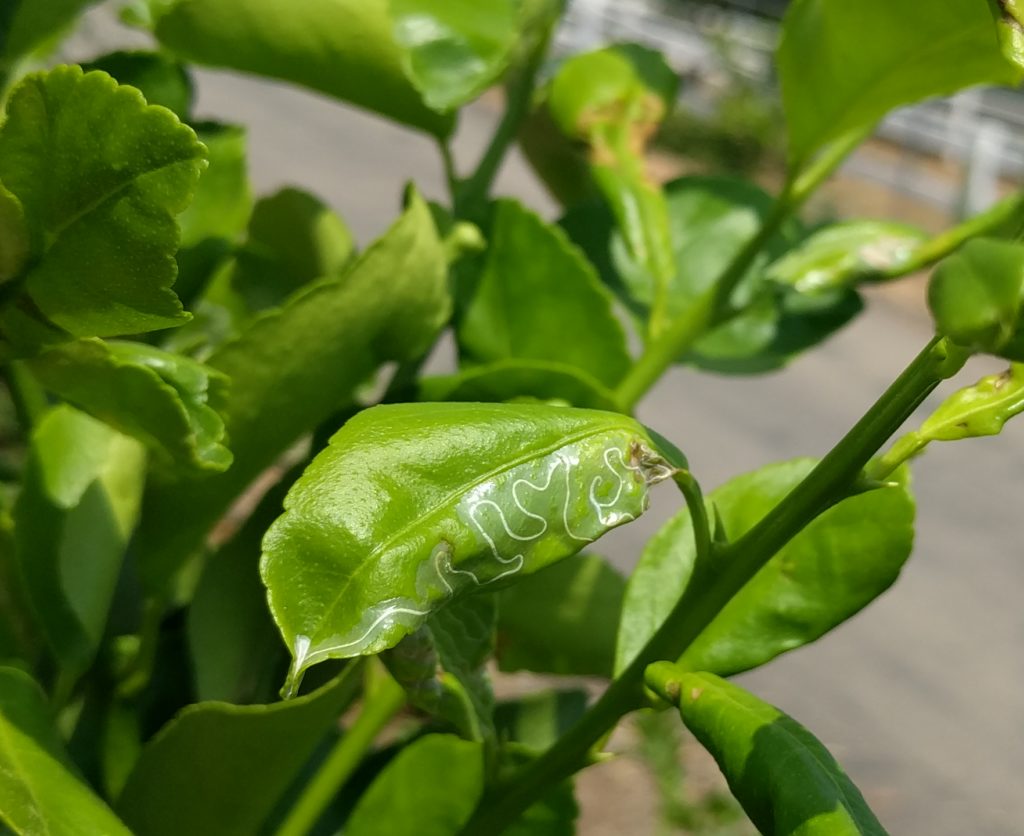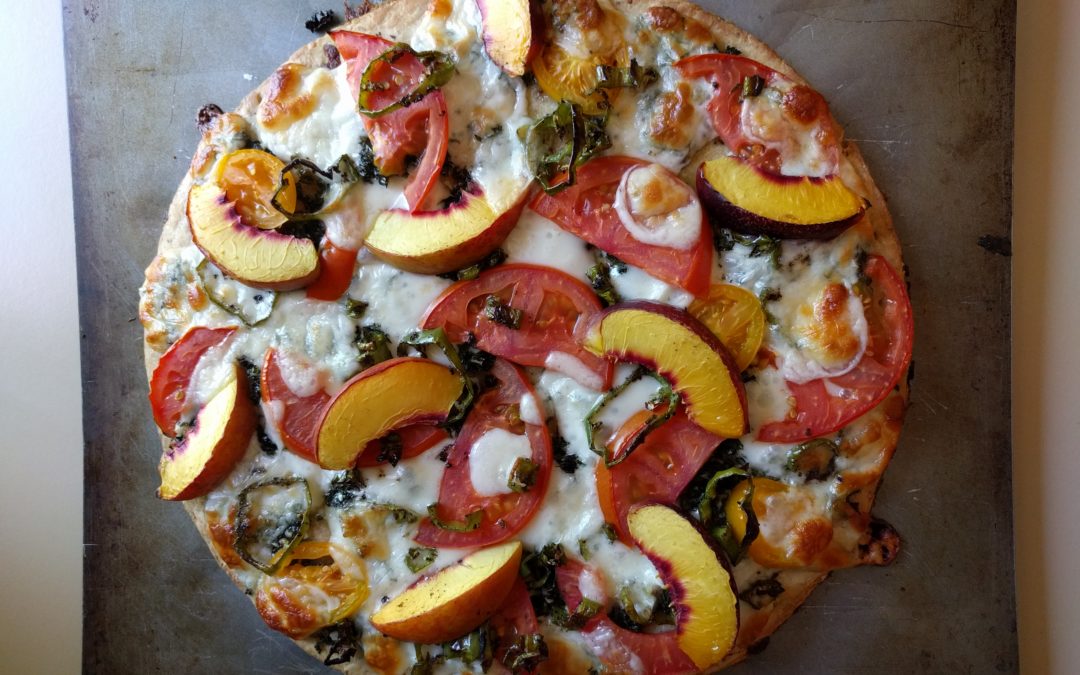Stay cool. Make shade. Have a drink. Go to the beach. Harvest in the morning. Harvest in the evening.
It’s summer for all of us now — inland it’s felt like summer for a month already; but within a mile of the beach, it usually only starts feeling summery around the Fourth of July.
Take it easy in the yard this time of year. You should have planted and set up irrigation already, when it was cool. Your only job now is to reap and eat.
Make yourself a “Garden on a Pizza” pizza, like the one I made in the photo above. You can’t go wrong, just pick and chop and place. On that one I added basil, garlic, peppers, and tomatoes from my garden, plus nectarines that my mom brought me from her tree. Spicy and sweet.
While July is the zenith of summer harvest activity, it’s the nadir for planting. If you do plant — vegetables or fruit trees — the key is to thoroughly water the soil surrounding the planting hole. The moisture there from the winter rains is now all but dried up, and that dry soil will literally suck the water out of the hole where you put in a new plant. So, upon planting, water about six inches to either side of a new vegetable and two feet to either side of a new tree, and soak it so the water goes deeper than the plant’s roots. It’s vital. I’ve learned this lesson the hard way, having lost plants or spotted them suffering because I was in a rush or lazy and didn’t do such watering.
In addition . . .
Sow and plant
– Sow or plant these vegetables any time in July (these produce before it cools down in the fall): basil, beans, corn
– Sow seeds of brassicas, the “cole crops”: brussels sprouts, cabbage, kohlrabi, broccoli, cauliflower (see my post, “Starting brassicas in summer”)
– Continue sowing potatoes under fruit trees where the soil remains a bit cooler (“Growing vegetables under fruit trees”)
– Plant seedlings of these vegetables, preferably no later than mid-July: tomatoes (small-fruited types like cherry are safest, but see note below on “fall tomatoes”), tomatillo, pepper, squash (“summer” types like zucchini and yellow crookneck are sure bets for a fall harvest), sweet potato (slips); if you plant later than mid-July there’s a good chance you’ll get little harvestable fruit before it cools in the fall

– Plant “fall tomatoes” by mid-July; I find that early planted tomatoes (March) tend to become less productive toward the end of summer and into fall, so my habit is to plant a few new ones in early July in order to ensure fresh tomatoes off the vine throughout fall; I planted a handful of varieties on July 8, 2016 and got decent production from most, but the best were ‘Champion’ (photo above); an ideal site for fall tomatoes is one that will get low-angle, southern sun in the fall so the fruit continues to ripen well at that time
Harvest and eat
– Eat these vegetables (had you planted them): tomatoes, tomatillos, potatoes, corn, greens, onion, garlic, lettuce, beets, carrots, peppers, eggplant, squash, basil, cucumber, melons, beans
– Eat these berries and fruits (had you planted them): blueberries, strawberries, raspberries, grapes, avocados (Hass, GEM, Gwen, Lamb, Reed), Valencia oranges, apricots, peaches, nectarines, plums, SpiceZee nectaplums

Miscellaneous
– Give deciduous fruit trees a pruning if you want to keep them down in size; this lets more light onto lower branches throughout the rest of summer, which encourages those lower branches to be fruitful next year; see this post about why I keep my deciduous fruit trees pruned to about eight feet tall; and see this post about how to do the summer pruning

– Protect avocados from sunburn; if a branch is exposed to hot summer sun it will burn and the branch will decline in health, so apply a sunscreen of diluted white latex paint (as I wrote about in this post)
– Water deeply just before a heat wave hits; this is particularly helpful for vegetables and avocado trees (see this post for more about watering through a heat wave)

– Powdery mildew happens on squash leaves, tomato foliage, melon, cucumber and pumpkin leaves; but there is no magic bullet that will eliminate the disease; however, my experience dealing with powdery mildew in different gardens and watching others deal with it is that plants in dense gardens suffer from it more; plants in gardens closer to the ocean suffer from it more; plants in some shade suffer from it more than those in full sun; moreover, some years it’s worse than others, and some varieties of certain plants (such as tomatoes) get it worse than others; finally, as some kinds of plants get old, such as squash, they almost always get it; see this webpage from the University of California for photos of powdery mildew and details about its growth and methods of control

– Stress not about those squiggly tracks caused by leafminers on your citrus leaves; citrus trees usually flush new growth around this time and little insects called leafminers like this new growth, but fear not because they don’t do serious harm to a tree and they don’t do any harm to the fruit; the damage is basically cosmetic; see my post about leafminers on my lime tree a few years back
– Heat getting the best of you? Try night gardening
The Yard Posts has no ads because it’s directly supported by cool gardeners like you. Learn more HERE
All of my Yard Posts are listed HERE




I just wanted to say thank you for making a monthly planting/harvest list for Southern California. I grew up in Hawaii and everything grows there, so moving to SoCal has been a challenge for me to have to pay attention to seasons and when to plant. This makes it so much easier for a beginner to start a garden here.
Thanks, Erlene. I wrote this post for someone exactly in your situation. Great to hear it’s helpful.
I plant tomatoes the last half of August for a winter harvest. Plants mostly set fruits through December that ripen through the winter. I used to think Italian Goliath was the best variety, but that has deteriorated. For simplicity I now use Big Beef. Works OK.
Hi Don,
Glad you wrote. I’m going to start some Big Beef seeds within the next week or two, hopefully getting them in the ground in mid August.
I haven’t bothered with winter tomatoes for the last few years, except cherries, because after early December they always ripened so slowly and didn’t achieve much flavor. But it’s time I give it another go, this time with your recommended variety. Thanks!
We appreciate all your posts and especially that the entire visit is ad free!
Thank you and all those who are helping to keep this experience and information sharing ad free!
Thanks for taking the time to share this, Kevin!
1st timer here. Do I pull the whole plant( tomato, pepper, cucumber) out when resowing or do I chop it at the base?
Thank you soooo very much for sharing your knowledge here.
Hi Greg, I just lost my loquat tree of 25 years and would love to replace it with a better variety, a bit larger fruit and sweet. Don’t remember what type it was that I planted so many years ago, it had a Japanese name but wasn’t terrible sweet, and smaller than another tree I had even more years ago. Just looking for a recommendation and possibly where available.
Thanks for all of your posts! I love them!
Hi Palinka,
Most of my experience with loquats is with unnamed seedlings, but one variety that I have tried and liked is Big Jim, which is on the large side and sweet so it might be to your liking.
Where to buy one? I don’t know! I’ll ask around. Thanks!
Thank you for your Gardening helps and information, especially, in regards to the avocado trees. We live in Fallbrook, and the heat of the summers, (notably), when the Santa Anna winds come at the end of summer, are death to the few avo trees that I have tried to maintain in my small yard. ( I had 6 trees).
The other threat to having a great avocado season, are the (high) water bills that come every 30 days. Yikes!!
One of my oldest trees and best producers for years, is one of my furete trees. It’s always outproduced everything else in the yard. This past year, the fruit (furete) went from a huge, smooth skinned, with huge seed, to an avocado, that has skin that looks more like a Hass.
One of my avo farmer neighbors, says that it looks like a” Pinkerton”.
I do have one Pinkerton growing about 40 feet away, (down the embankment) of the yard.
Is that possible for an avo tree to suddenly change like that? I don’t graft my own trees, and I haven’t done any pruning to the tree, ever, which might have damaged or affected the original bud union at the base.
I’m a little sad that this year, my flowering was very small, and I see only a few small (peas) that have held on this season. This tree is about 25 years old. It’s never had a bad year of fruiting. Maybe it finally needed some (much earned), rest for a season.
I grow the avocados, to give away to friends and to the local food shelter in town.
Growing avocados, just seems like a part of living in Fallbrook for 60 years.
Thanks, again, for your great information.
Hi Greg!
Our yard has recently been landscaped and now I have no place to plant my Haas avocado tree that has been in a pot for almost a year. I was told by the landscaper to plant it in a big pot. It’s about 5 feet tall. What size and or type of pot do you recommend? I live in Yorba Linda, CA.
Also, is it true that I am able to plant tomatoes and zucchini this late in the year?